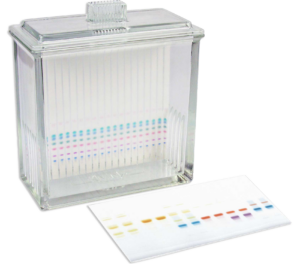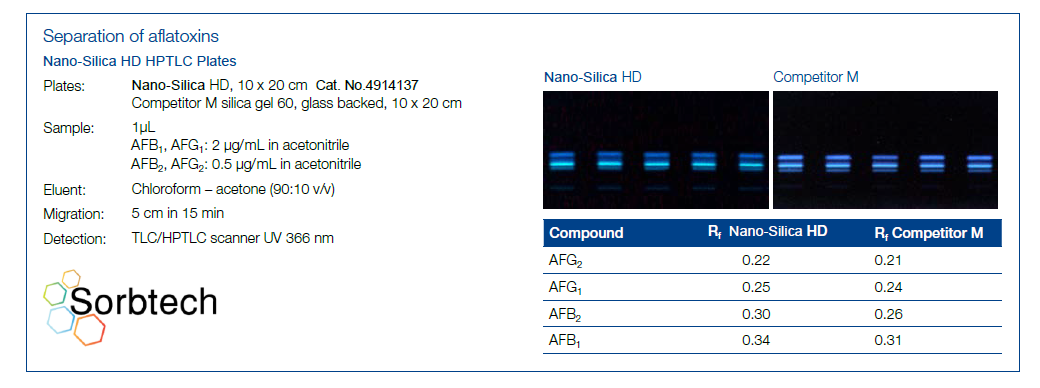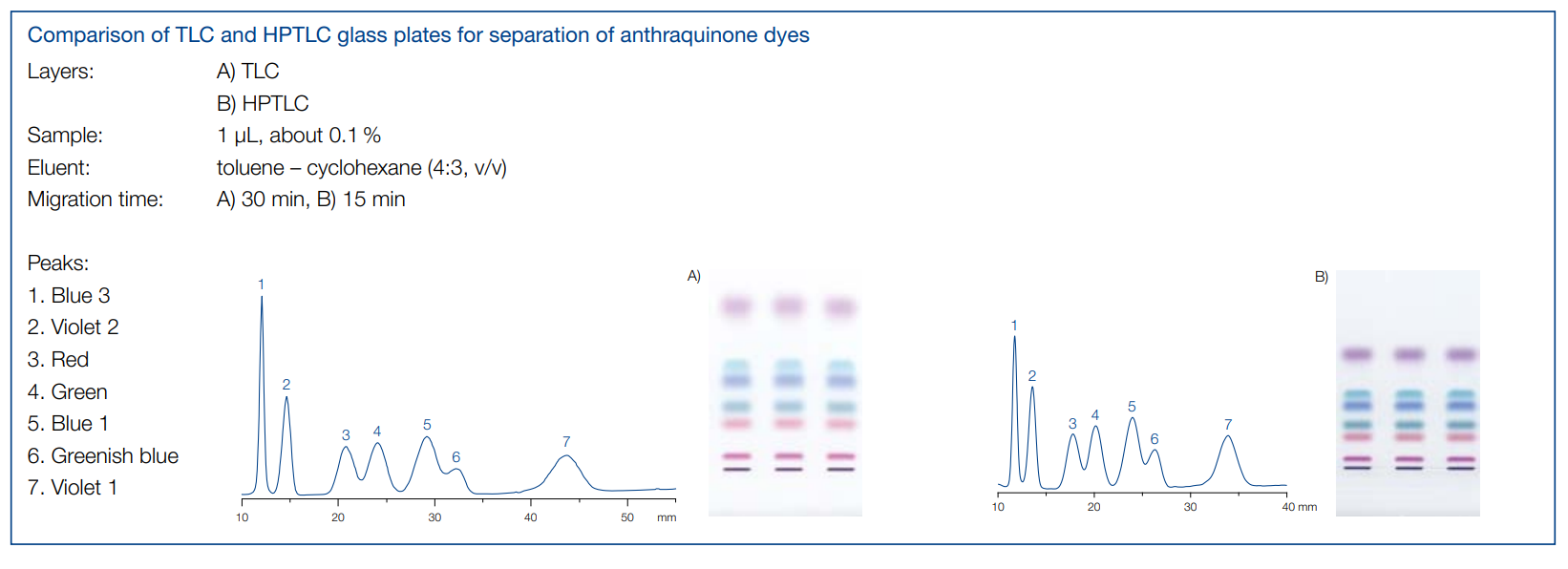HPTLC – High-Performance Thin Layer Chromatography
Increased sensitivity, improved speed and resolution when compared to standard analytical TLC
 HPTLC plates feature a smaller particle size (≤10 μm), and a narrower particle size distribution as compared to standard analytical TLC. Higher packing densities and smoother surfaces, highlighted by greater luminosity in development, make HPTLC a powerful alternative to standard analytical TLC.
HPTLC plates feature a smaller particle size (≤10 μm), and a narrower particle size distribution as compared to standard analytical TLC. Higher packing densities and smoother surfaces, highlighted by greater luminosity in development, make HPTLC a powerful alternative to standard analytical TLC.
HPTLC benefits:
- More resolving power per unit distance
- Small sample amounts (0.01 – 0.1 µL)
- Minimized solvent usage vs standard analytical TLC
- Highly reproducible, focused bands for quantitative analysis
- Ideal for instrument-supported applications
- 5 to 10 times better detection sensitivity than standard analytical TLC
| HPTLC vs. Standard Analytical TLC - Silica Gel | ||
|---|---|---|
| Feature | HPTLC | TLC |
| Mean Pore Size | 60 Å | 60 Å |
| Specific Pore Vol | 0.75 mL/g | 0.75 mL/g |
| Particle Size | 2-10 µm | 5-17 µm |
| Layer Thickness | 0.20 µm | 0.25 µm |
| Common Migration | 3-9 cm | 10-15 cm |
| Detection Sensitivity | >5-10x | Good |
| Sample Volume | 0.01 - 0.1 µL | 1 - 5 µL |
| Minimized Diffusion | Excellent | Good |
| Analysis | Quantitative & Qualitative | Qualitative |

Our Nano-Silica HD HPTLC plates vs. competitor HPTLC plates.
Noticeable improvement in Rf values vs. competitors.

HPTLC plates improve TLC performance with shorter migration times,
tighter elution bands, and increased sensitivity.
| HPTLC Plate Type | Description | Features |
|---|---|---|
| Nano-Silica HD HPTLC | Contains a specific pore volume of 0.75 ml/g and particle size of 2-10 µm. | Narrow fractionation of silica particles allows sharper separations, can lead to shorter developing times, shorter migration distances, and increased detection sensitivity |
| C18-W HPTLC | Normal Phase or Reversed-Phase separation modes with eluents from anhydrous solvents to mixtures with high concentrations of water. | Separation of very non-polar and highly polar substances using aqueous solvent systems. Use to determine solvent system composition for downstream HPLC analysis. Provides additional selectivity’s as compared to Silica Gel plates. Very fast migration times. |
| C18-100 HPTLC | Octadecyl-Modified Nano Silica Layers, Complete (100 %) octadecyl modification, carbon content 14%. | Reversed-phase separation mode with eluents from anhydrous solvents to mixtures with up to 20% water. Use for Alkaloids, amino acids, barbiturates, polycyclic aromatic hydrocarbons (PAH), drugs, peptides, flavonoids, phenols, indole derivatives, steroids. |
| C18-50 HPTLC | Octadecyl-Modified Nano Silica Layers; Partial (50%) octadecyl modification, carbon content 7.5% | Reversed-phase separation mode with eluents from anhydrous solvents to mixtures up to 60% of water Use for· Alkaloids, amino acids, barbiturates, polycyclic aromatic hydrocarbons (PAH), drugs, peptides, flavonoids, phenols, indole derivatives, steroids. The 50% carbon load is less retentive than the C18-100. |
| Amino HPTLC | Aminopropyl modification, carbon content 3.5% | Moderately polar can be used in both normal and reversed-phase modes. Use to separate hydrophilic or charged samples, vitamins, sugars, steroids, purine derivatives, xanthine, phenols, nucleotides, and pesticides. |
| Cyano HPTLC | Cyanopropyl modification, carbon content 5.5% | Moderately polar can be used in both normal and reversed-phase modes. Use to separate hydrophilic or charged samples. Steroid hormones, phenols, preservatives. |
| Diol HPTLC | Diol modification, carbon content 5.5% | Moderately polar can be used in both normal and reversed-phase modes. Steroids, pesticides, and plant constituents, less sensitive than silica to the water environment. |


